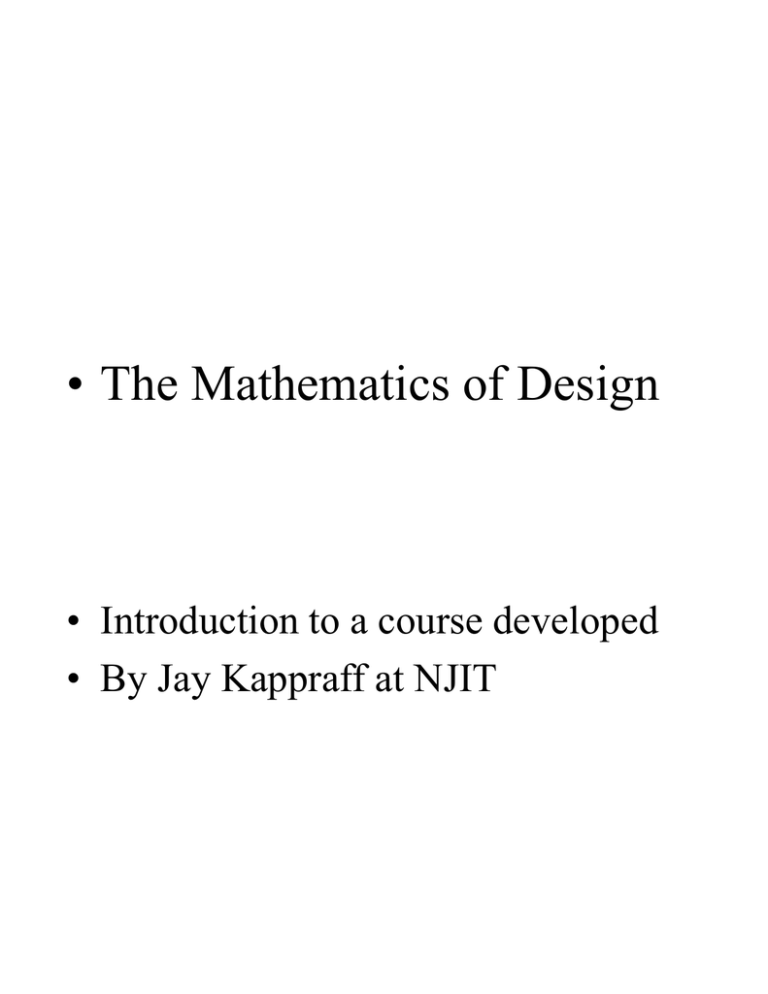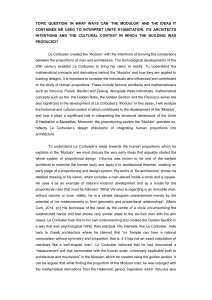The Mathematics of Design
advertisement

• The Mathematics of Design • Introduction to a course developed • By Jay Kappraff at NJIT Pedagoqical Levels • 1. Metaphor and creativity • 2. Two and three dimensional design concepts • 3. Mathematical concepts – geometry and algebra • 4. Communications and literacy • Pedagogical Objectives • • • Topics are arranged into independent modules. A spiral model of learning is used rather than a linear model --Concepts return in different contexts. Most topics are connected at different levels. Each module should contain significant mathematical content. Course addresses a variety of design ideas such as: symmetry, symmetry breaking, duality, positive and negative space, mathematical constraints on space, the nature of infinity, modular design, etc. Pedagogical Objectives (continued) • Algorithms to carry out design activities are emphasized rather than basic theory. • Designs derived from different cultures both ancient and modern are emphasized. • Most design activities are either adapted to the computer or are computer applicable. However, the first stage of the design process is generally hands on or constructive. • Materials are ungraded – they can be adapted to students from the 3rd grade to students on the graduate level, both mathematically oriented and non-mathematical students • The course emphasizes writing and communications. . Evaluation of Students • • • • • • Scrapbooks Journals Design projects Homework exercises Essays No examinations Main Topics • • • • • • • Informal Geometry Projective Geometry Theory of Graphs Theory of Proportions Fractals Modular Tilings Three-Dimensional Geometry and polyhedra • Theory of Knots and Surfaces • Symmetry and Music Examples of Modules in this Presentation • 2-D and 3-D lattice designs • Proportional system of Roman Architecture (silver mean) • Golden mean and Le Corbusier’s Modulor • Brunes star • Tangrams and Amish quilts • Sona and Lunda tilings • Penrose tilings • Hyperbolic geometry • Projective geometry and design • Lindenmayer L-systems and fractals • Traveling salesman problem and design • Application of fractals to image processing • Spacefilling curves and image compressing • Music – the diatonic scale and clapping patterns Informal Geometry 1. 2. 3. 4. Tangrams and Amish quilt patterns Brunes Star Coffee can cover geometry Baravelle spiral Theory of Proportions • 1. Modulor of Le Corbusier • 2. Roman System of Proportions The Modulor of Le Corbusier • Blue 2/ 2 2 22 23 24 25 … • Red 1 2 3 4 5 6 • … Unite’ House of Le Corbusier designed with the Modulor Mosaic with rectangles from the Roman system at three scales The System of Silver Means based on Pell’s Series • • • … 1/ 1 2 • … 2/ 2 2 • … 2/ 2 2 22 Tiling Patterns • • • • • • • • 1. Op-Tiles 2. Truchet Tiles 3. Kufi Tiles 4. Labyriths 5. Sona Sand Drawings 6. Lunda Patterns 7. Penrose - Islamic Tilings 8. LatticeTilings Traveling Salesman Designs • Tilings based on approximate Hamilton paths • by • Robert Bosch Symmetry and Music • 1. Heptatonic scale • 2. Pentatonic scale • 3. African clapping patterns Nichomachus’ Table • Expansions of the ratio 3:2 • (as string lengths) • 1 2 4 8 16 E 32 • 3 6 12 24 A 48 • 9 18 36 D 72 • 27 54 G 108 • 81 C 162 • 243 • 64 96 144 216 324 486 729 B E A D G C F Alberti’s Musical Proportions • • 1 • • • 2 4 8 16 … 3 6 12 24 … 9 18 36 … 27 … Bi-symmetric matrices lead to generalizations of the golden mean sqrt 3 2 = 2 3 phi 1/phi 1/phi phi phi = golden mean 3 2 x 3 2 = 12 13 2 3 2 3 13 12 Where 52 + 122 = 132 Sqrt2 to 7 places derived from the musical scale 1,1,1,2 1 : 1 1,1,2,2 2,2,4,4 2,3,3,4 3 : 2 2 3 1, , ,2 3 2 4 3 1, , ,2 3 2 6,8,9,12 12,16,18,24 12,17,17,24 17 : 12 12 17 1, , ,2 17 12 24 17 1, , ,2 17 12 204,288,289,408 408,566,568,816 408, 577,577,816 577 : 408 Knot Theory • 1. Knots up to 7 crossing • 2. Curvos • 3. Knots and surfaces
